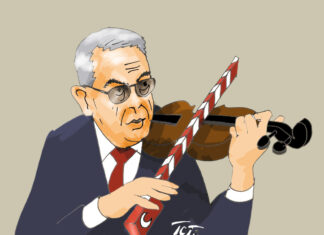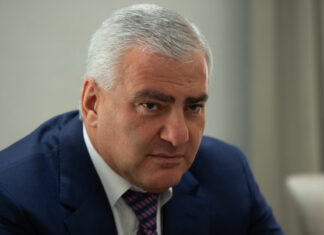As Armenia – Azerbaijan peace talks stalled and Azerbaijan resumed its military pressure tactics against Armenia and the self–proclaimed Nagorno Karabakh Republic (NK), international actors accelerated their calls for regional peace and stability. The European Council President Charles Michel had phone calls with Prime Minister Pashinyan and President Aliyev, seeking to revitalize the Brussels format; Moscow heralded the upcoming Armenia – Azerbaijan summit in Russia, and the US organized a high-level Armenia – Azerbaijan meeting at the Munich Security Conference. Meanwhile, the recent actions by Azerbaijan, the killing of three policemen in Nagorno Karabakh on March 5, 2023, the assassination of the Armenian soldier near Yeraskh on March 22, and the attack against Armenian soldiers in Tegh village on April 11, as a result of which four Armenian servicemen were killed, have raised a legitimate question on the ultimate goal of Azerbaijan.
If we are to rely on the rhetoric of Azerbaijani officials, including President Aliyev, the latter seek to reach a peace deal with Armenia and secure long-lasting security in the region. However, the Azerbaijani understanding of peace in general, and the peace treaty in particular, have some peculiar features. Azerbaijan believes that a peace treaty should finalize the nonexistence of Nagorno Karabakh as a territorial administrative unit, with no special status for Armenians living there and no international presence to guarantee the rights of Armenians. As for relations with Armenia, Azerbaijan argues that any peace treaty should fix the current line of contact as a base for border delimitation and demarcation, which means that Armenia should recognize up to 200 square kilometers of Armenian sovereign territory currently under Azerbaijani occupation as legally part of Azerbaijan, and should give to Azerbaijan so-called “enclaves,” which will allow Azerbaijan to control strategic highways connecting Armenia with Iran and Georgia.
Thus, Azerbaijan pushed very tough demands on Armenia for the signature of the peace treaty. The leaders in Baku know very well that it will be very challenging for the government in Armenia to accept all these demands. The Armenian government has already made significant concessions, at first agreeing to discuss NK’s autonomous status within Azerbaijan, then dropping the term “status” from their vocabulary, focusing only on an international presence in Nagorno Karabakh to secure the rights of Armenians there. To drop also this point, and to agree that the Armenians of Nagorno Karabakh should live under Azerbaijani jurisdiction with no status and no international presence, would mean for the Armenian government to effectively agree to the hard or soft ethnic cleansing of Armenians and accept the vision of no or very few Armenians in Nagorno Karabakh. No political force in Armenia, including the ruling party, will probably accept these demands, as it will be perceived by at least part of the population as an apparent capitulation.
Thus, we may argue that Azerbaijan pushes forward demands which comprise a non-starter for Armenia. It resembles a negotiation tactic when a party is not interested in any deal and simultaneously seeks to blame another side for being non-constructive. Meanwhile, Azerbaijan has launched serious efforts to develop so-called the “Western Azerbaijan” concept, according to which part of Armenia, including the capital Yerevan, is a historical land of Azerbaijan, and hundreds of thousands of Azerbaijanis should settle in Armenia – and later perhaps make these territories part of Azerbaijan. Currently, Azerbaijan argues that the concept of “Western Azerbaijan” was created as leverage to force Armenia to accept Azerbaijani demands; however, very soon, this concept may become an official Azerbaijani position.
Meanwhile, as Azerbaijan continues its aggressive policy towards Armenia and the self-proclaimed Nagorno Karabakh Republic, many in Baku argue that Azerbaijan would receive what it wants, with or without a peace agreement. According to this logic, if Armenia rejects Azerbaijani demands to “forget about Nagorno Karabakh” and implement border delimitation and demarcation according to the Azerbaijani vision, then Azerbaijan will continue its policy of increasing pressure on Nagorno Karabakh Armenians, and ultimately, drive them out. Simultaneously, Azerbaijan may continue its “salami tactics” against Armenia, taking more and more strategic heights and creating a springboard for a large-scale attack against Armenia to open the so-called “Zangezur corridor” by force as soon as a window of opportunity emerges.
Azerbaijani policy and rhetoric create the perception that Baku is not interested in a peace agreement, and its primary concern is to blame Armenia for the failure of negotiations. In these circumstances, Armenia faces hard choices. Yerevan cannot fully accept Azerbaijan’s demands regarding the content of the peace treaty as it equals capitulation. Meanwhile, Azerbaijan will use the absence of a peace treaty as a “justification” for further military attacks against Armenia and Nagorno Karabakh. Perhaps the only way to cut this vicious circle is to make Azerbaijan pay a higher price for its military provocations and simultaneously reach out to external players, including Russia, the US, and the EU, with an Armenian vision of the future regional security architecture and seek to obtain their support in pushing forward these ideas.








